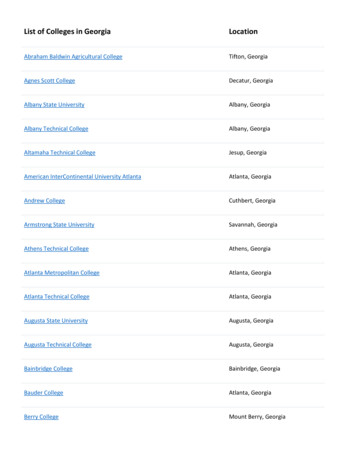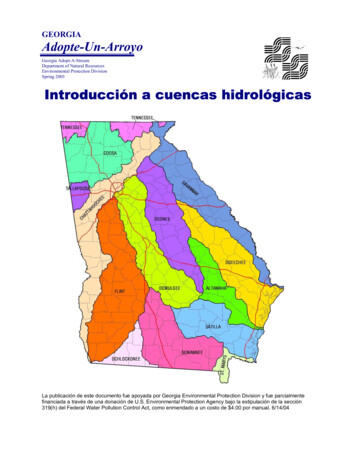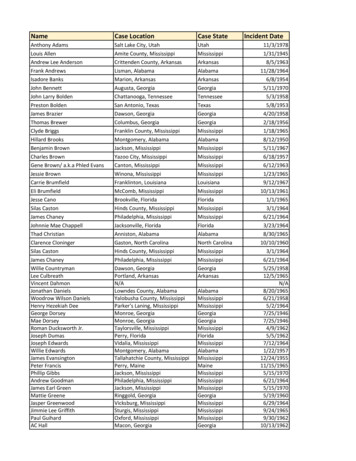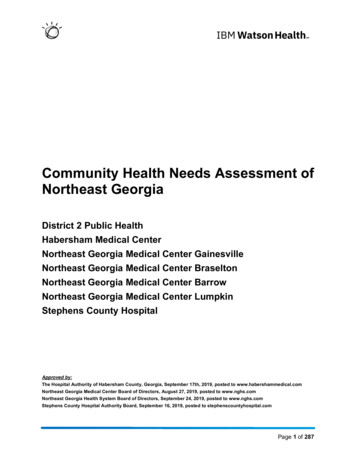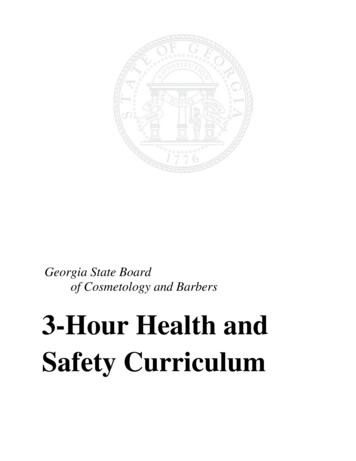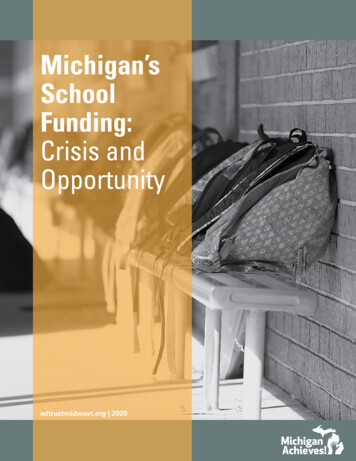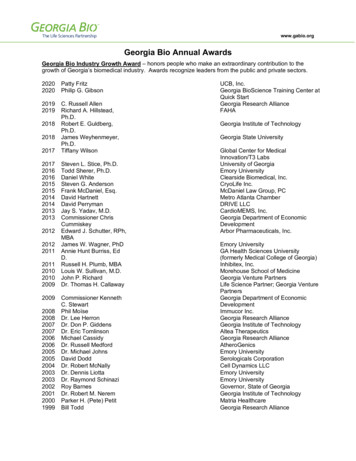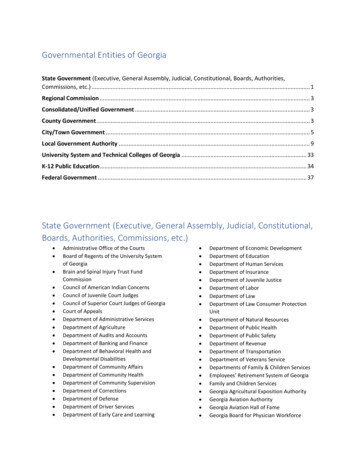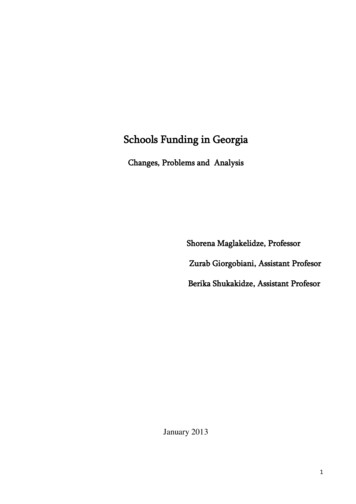
Transcription
Schools Funding in GeorgiaChanges, Problems and AnalysisShorena Maglakelidze, ProfessorZurab Giorgobiani, Assistant ProfesorBerika Shukakidze, Assistant ProfesorJanuary 20131
AbstractThere is no fixed rule about how financial resources must be directed to the educationsector. It is quite clear that the size of investment in the sector well defines the quality ofeducation students are offered. It is highly important to define the amount of money,which is needed for effective functioning of schools and it is also important to define thesystem of actions, which will support the functional use of those financial resources.In relation to the above-mentioned, the aim of our study is to analyse general educationfunding during the post-reform period and based on it to show those problems, which, inspite of the significant rise in funding, arouse as a result of implementing a new system andits further change.Data sets for the research project were taken from the Ministry of Education and Science ofGeorgia, National Statistics Department of Georgia and directly from public schools. Theobject of study is all public schools in Georgia, and the period of data gathering is from2005 till 2011.The rational for conducting the study is due to the necessity: the new funding system for thegeneral education schools drastically changed general education finance model. Although, anumber of schools fallen under so called deficit school category in the first year of implementationof the new funding system. Period more than 1300 public schools (out of 2180) had shortages in thebudget. In 2011 a new, mixed type of funding model was introduced, schools with up to 160students were funded using so-called need based approach. Under the new funding model schoolswith student population from 161 to 599 receive base funds. Even though this approach has workedwell in terms of eradicating deficits, a number of essential problems were originated.In the paper, the authors present some conclusions and recommendations on how to solvethe existing problems and how to improve the financing model in the future; one of themost important conclusions is that voucher funding scheme couldn’t manage to accomplishgeneral education funding goals relating fairness, adequacy and effectiveness. This willonly be possible (a recommendation), if expenditure on education as a share of GDPincreases by at least 4.5-5% (it was 2.3 in 2011). Shifting to the formula funding is amongthe recommendations; it will guarantee: balance between the regions, stability,comparability, forecast and it will raise the quality of transparency.2
IntroductionMost of the countries allocate big chunk of financial resources for development of the field ofeducation. Since there is a higher probability that educated person will have proper knowledge andskills to be a better citizen by contributing in economic, social and political development of thesociety, quality of education, starting from the pre-primary education sector, is very important.When we talk about education finance, we mean the share of education expenditure in GDP.Broadening education opportunities is directly related to funding education policy. Over the lastdecade education finance has gained utmost importance in Georgia. Alongside a number ofsweeping social and economic reforms education reformation process has taken place.We single out the issues that are related to education finance and determine the effectivenessdegree of the reformation process. Those issues, listed below, need to be inquired farther by thedecision-makers, policymakers, researchers and education administrators: The volume of investment in the field of education The list of effective mechanisms of distribution of public money Financial management process in educational institutions. Relationship between the learning outcomes and education financial resources. The role of private sector and household in funding education sector.There is vast variety of best practices in different countries regarding to resolution of the abovementioned issues. In the science literature, a special attention is given to the development of thegeneral education sector and accordingly to define best possible funding formula. Also, to identifythe relationship between the student learning outcomes and expenditure per student. Thosefindings could be used to monitor the spending practice and policy of educational institutions. Eventhough, there is no fixed rule how to direct financial resources to education sector, it is quite clearthat the size of investment in the sector well defines the quality of education students are offered. Itis highly important how to define the amount of money that is needed for effective functioning ofschools. In some cases, it is mistakenly perceived that the raise of funding amount is a cure of theproblem. The automatic process of allocating more money for the educational programs will notguarantee the raise of students’ academic performance. That type of strategy cannot be consideredas the way-out. This assumption is well – proved by a number of research findings. Hanushek andothers assert that the increase of education funding doesn’t necessarily translate into an increase in3
students achievements (Hanushek and Kim, 1995). However, it should be mentioned that thisfinding applies well to developed countries. Money does matter when it comes to developingcountries’ education systems. Since Georgian belongs to the developing counties group, it is vitallyimportant to allocate more money in the education sector.The purpose of this study is to analyze the period after general education funding reform in Georgiaand revealing the problems followed by the introduction of a new system of funding. For this we:analyzed general education funding mechanisms, which took place after education reform inGeorgia in 1005-1010(1), also studied changes and results in funding system since 2011 (2).“Law on General Education“(2005) determined the general education system setup, operation,management and funding model, which cause significant increases of school funding.However, during the first years of voucher funding a lot of schools reported that the funding wasnot sufficient for them and they needed additional money to cover salaries and other costs.The slight increase in the voucher amount, which took place in the years of 2006-2010, could notsolve the budget deficit problem.Under the Georgian government resolution #395 (23.12.2010) (About calculating financial normper student and determining respective standard voucher amount for funding general education),the scheme for funding education changed. According to the new scheme, school funding becamemixed.The only major advantage of the new funding system is that budget deficit at schools has shrunk,which has resulted in the fact that school staff now receive their salaries on time.Nevertheless, this funding system has a lot of drawbacks, which makes us say that funding must beincreased in order to improve education process at schools, after which formula financing should beadopted, the model approved by European countries.4
1. Education Reform and General Education Funding1.1 General Education FundingOne of the most important issues, which helps a school function normally, is funding.“Law on General Education“(2005) determined the general education system setup, operation,management and funding model.The basic approach to the reform implies that the education system should serve the needs of pupilsand students, their capabilities and interests, but not those who are involved in the educationalprocess, educational administrators and teachers. Government and the Ministry of Education andScience prepared the strategic documents stating the long-term goals about the major changes inthe sphere of education and science: Social Inclusion – is a formation of an education system that will ensure the maximuminvolvement of all citizens of Georgia in the educational process; Civic Integration – is the integration of ethnic minorities in the society with the help of statelanguage teaching and education oriented programs; Competitiveness – is the establishment of such education and science system which will equallycompete with European science and education system. Facilitating the development of knowledge-based environment in which knowledge, asproductive force, plays the crucial role in the creation of capital.To achieve these objectives, the Ministry of Education and Science has prepared the strategy ofactions: Democratization of the education and science management process and wider public involvement; Decentralization of the education system and the provision of educational institutions withautonomy; Establishment of quality assurance schemes for the education sector, result oriented managementand resource allocation mechanisms; Increase funding for the education sector and the development of material - technical framework; Develop new mechanisms for funding the education sector;5
Establish the educational environment in accordance to modern standards; Worldwide integration of education and science, the development of science and educational –research centres in high schools. Creation of favorable conditions for the continuous education and life-long learning; Promoting inclusive education.Altering the general education sector financing model has been one of the key changes since thereform has been implemented. Other than changing the context of the funding formula the amountof money allocated for the general education sector has increased considerably. Without newfunding formula is would be rather hard to support successful implementation of the reformdirections. Since 2003 Georgia has one of the fastest growing economies in the region. Thattranslated into a raise of the Gross Domestic Product (GDP) and consequently the national budgethas increased. The following chart shows a flow of GDP and general education expenses from 2004to 2001.GDP and State Expenditures on EducationTable 1.120042005200620072008200920102011million .5379.3419,6497.6542,1564,92,23%2,76%2,61%2,33Line itemGDP(inGeorgian n Lari)Education expensesas a share of GDP0.65%0,76% 2,41% 2,70%Source: www.GeoStat.ge, www.mof.ge Authors’ calculationUp to 2009 the growth of GDP has been stable 12-13%. From 2009 on the growth of GDP hasdecreased due to war with Russia in August, 2008 and global economic crises. As it is shown on the6
chart money allocated in the general education sector increased noticeably from 2004 to 2011.While the money allocated on the general education sector in 2004 was 89.7 million Georgian Lari(GEL) in 2011 the amount increased 6.3 times, totalling 564.9 million GEL. However it should bementioned that the small amount of money allocated in the general education sector in 2004-2005fiscal year is due to the fact that at that time big chunk of money was taken from the localgovernment budget.From 2006 per capita financing model has been introduced for generaleducation schools (both public and private). From 2009 there is a tendency of lessening of a share ofeducation expenditure in GDP. Group of researchers argue that one of the contributors of thisprocess is that from 2008 all Georgian schools introduced 12 th grade. Also, there has been increasein teachers pay. However the percent of certified teachers, who are paid extra money, was very low(up to 10 %).Growth Rates of GDP and State Financing of EducationFigure 1.17
We analyzed all the funds allocated on education sector and then singled out a share ofgeneral education sector. We calculated expenses per student and for the general educationdevelopment program considered by the Ministry of Education and Science of Georgia.From 2006 the general education sector is mostly financed through the central budget. Thefunds were accumulated in the Ministry of Education and Science budget. Expenses for generaleducation sector represent 60-65 % of the entire ministry budget. All the costs for public schoolsoperations (partially private schools) are covered that program – teachers’ salary, heating and othermaintenance and office operation related expenses.Indicators of State Financing for EducationTable 1.2Source2004200520062007200820092010national budget (In million 1 930.2 2 618.6 3 822.5 5 237.1 6 758.8 6 754.1 6 972.320117.459.3GEL)State funds for education 89,789.4332.5379.3419,6 497.6542,1564,937.0267289.1315.3 ,75,15.2546.0420470.3490.1 512.7589.3689.7(in thousands GEL)Statefundseducationforgeneral(in thousandsGEL)State funds for education as 3,4a percentage of the nationalbudgetStatefundsforgeneral 1.0education as a percentage ofthe national budgetPer capita amount (GEL)29,3Source: www.GeoStat.ge, www.mof.ge, Authors’ calculation8
As it is shown in the chart GDP as well as national budget is growing steadily (1,1-1,4 %), except2008-2009 fiscal year. Even though there has been permanent raise in education sector funding it istoo low as a share of the national budget.Share of Education Expenditure in the National BudgetFigure 1.2100%90%80%expenditure of Statebudgetshare of education70%60%share of 0082009201020112012(plan)As mentioned earlier, the raise of funding education sector, especially general education, at the firststage of the reform was exceptionally high. However, that amount was not enough to cope with allthe challenges and problems (post Soviet era legacy) the education sector was facing.9
Expenditure per studentFigure 11Expenditure per studentIt is clear that GDP, as well as the expenditure on education as a percent of GDP have risen from0.65% (2004) to 2.41%, the growth has slowed down and has been close to 2.5%: sometimes itslightly exceeds this percentage or is slightly under it. Education expenditures from the state budgethave also increased, resulting in the increased education expenditures per student. As we will seebelow, it is not enough at all.If we look through he data of various countries of the world for the same period, we will learn that,according to the European Union 27, education expenditures was 5.4% of GDP in 2009.Expenditure on education, as a percentage of GDP was highest in Denmark (8.7%), Cyprus (8.0%),Sweden (7.3%), Finland (6.8%), Belgium (6.65), Ireland (6.5%), Estonia (6.09%); the percentage isalso high in East Europe’s countries and Baltic States (6.09-5.64%), from which Romania has thelowest (4.24%), whereas it was 2.76% in Georgia in 2009.Expenditures per student also vary. The USA spends 10.995 per elementary and secondarystudent, which is 35% more than the average of Organization for Economic Co-operation andDevelopment (OECD) countries, which is 8.169. Expenditures per secondary student in the USAwere 29.910, twice as big as the average of Organization for Economic Co-operation and10
Development (OECD) countries, which is 13,461 on average. Education expenditures per studentis also high in Switzerland, which is 13,775 in the elementary stage and 21.648 in the next stage.In Norway it was 12,070 and 18,942 . The percentage is relatively low in East Europe’s countriesand is 682 and 7,063 in Poland and 4,626 and 7,327 in Hungary etc. (eurostat.ec.europa.eu2010). But those figures are significantly higher than the corresponding figures in Georgia.While discussing programs focusing on development general education sector we should pay someattention to program(s) that are targeted to improve infrastructure of Georgian public schools.The Soviet and post Soviet legacy in terms of school system infrastructure has been one of thebiggest challenges the government has been facing for years. Before 2004 it had been 20 yearsnothing tangible done as far as schools infrastructure is concerned. Almost all, if not all schools,especially in the peripheral regions and high mountainous villages were dilapidated, equipped withoutdated furniture and teaching resources, heated with wood stows. Consequently, all that playeddetrimental role on teachers and students performance. Since 2005-2006 school years a nationalprogram “Jacob Gogebashvili–Rehabilitation of Georgian Public Schools” has been introduced. Themain goal of the program is to create modern and safe environment for all students. The program isfocused on to renovate, to equip with proper furniture and teaching resources. Another program“Deer Leap”, launched in 2005, is focused to equip schools with computers and other IT equipmentsand to connect schools and Educational Resource Centres (ERC) to the World Wide Web. Theprogram was designed based on the best practices of Estonia (“Tiger Leap”). Nationwide program“My New Computer” has been launched with patronage of the President of Georgia and is focusedto foster IT integration in the learning process.Infrustructural ProgramsTable 1.3Years2005200620072008200920102011Jacob Gogebashvili– Rehabilitation ofGeorgianPublicSchools731 .073 472.078 831 00024 139 40035 500 00013 775.037 736.2Deer Leap2 822.62,623.402 723.56 923.22 362,13 064.024 903 974,3Source: Ministry of Education and Science of Georgia http://www.mes.gov.ge11
1.2 Introducing Voucher SystemIn 2005 Georgian government enacted a new general education law which defined a fundingsystem for general education schools. Based on the new system, schools would receive funds fromthe central budget based on the norm calculated per student. The amount did not include funds forthe capital expenses.Under the previous law schools received funds from two different sources: central and localbudgets. That approach caused the following problems: Ineffective use of funds. In order to receive more money from the government, schoolsdeliberately raised number of classes, which would translate into increasing number ofteaching hours. Schools had more teachers and administrators than they were in need. Transfers from the central budget were not calculated based on the needs of specificregions. For this reason, wealthy regions would get more money than the poor ones. Lack of transparency was another challenge, especially at the local level. Getting fundsfrom the local budget was depending on school administrators and local governmentrepresentatives’ suspicious agreement.In 2005 Georgian government issued a decree # 182, which defined how to fund generaleducation schools, both public and private.Base voucher amount was defined as 220 GEL.Coefficients were determined as follows: city schools -1; rural area schools - 1, 5; and highmountain region schools – 1.8.Schools were given freedom to spend money for constriction or/and renovation purposes ifthey would have spare amount of money after meeting the needs of national curricula.The new funding system envisioned to reach several goals: to meet the needs of low socioeconomic students (mostly resided in rural and high mountain regions); to supporting the schoolenlargement process throughout the country; and to promote privet school network.12
1.3 I Stage of Voucher Funding–Reducing the Number of Schools and Increasing socalled Deficit SchoolsBefore 2005-2006 school year there were 2733 schools around the country. After the newfunding system was introduced about 200 schools were closed, merged with bigger schools.Distribution of Schools and Students via Voucher SizeTable 1.4Voucheramount in NumberGELSchools220of NumberClassesof NumberStudentsAverageschoolof sizeAverageclass 09,122823603359967726316,62005- 3302006 3962006- 3302007 396TotalSource: Ministry of Education and Science of Georgia, http/mes.gov.ge, Authors’ calculationA parallel process of that cased shortening a number of schools in the rural and highmountain regions were that more and more people left the regions for city.Students’ Portions in Different Type of SchoolsTable 1.5CityRuralHigh %11,6%Source: Ministry of Education and Science of Georgia, http/mes.gov.ge, Authors’ calculationUnder the new law schools enjoy maximum financial autonomy. Most of the schools decided to hiremore teachers. City schools hired 742 and rural schools 458 more teachers in total. There wasdecrease in number of teachers in high mountain regions. However teaching load was increased. Eventhough policy makers envisioned that a teacher-student ration would increase, the new model causeda slight decrease of the ratio (from 8.72 to 8.6).13
The major problem caused by the new law was so-called deficit schools (schools with deficitbudgets). Because, the majority of public schools in Georgia have small number of students, fundsreceived based on the number of students are not enough to pay all the operational expenditure(personnel salary and utility expenses). That fact was taken into consideration for the highmountain region schools. By the law they were eligible to receive additional funds from the centralbudget. In 2005-2006 school years 874 public schools had less than 100 students. Only 71 publicschools operated with more than 1000 students.The Distribution of Schools by Their Size and Number of StudentsTable 1.6School sizeNumber of schoolsNumber of studentsSchools 92466Total24706015502466Source: Ministry of Education and Science of Georgia, http/mes.gov.ge, Authors’ calculationNew law defined the minimum/base teacher salary – 115 GEL. The following components weredefined to calculate teacher salary: education level, qualification, experience, and number ofstudents in the class. After reviewing the data we found that in 2005-2006 school year about someschools did not have enough money to pay for the base salary to the teachers.If we take account that teachers salary represents the majority of the school expenses ( up to75%) the number of schools that had problems to pay due increased up to 833 schools ( 1/3 of theall schools).1.3II Stage – Problems of Voucher Funding ModelAs mentioned earlier, during 2006 -2009 the size of voucher amount changed several times. In 2006the base voucher was defined 234 GEL. Coefficients were changed the following way: city – 1; rural14
– 1.49; high mountain – 1.8. Changes were made in 2007 as well. In 2008, base voucher was defined325 GEL. Coefficients were changed the following way: city – 1; rural – 1,385; high mountain –1,738. In addition to that schools with students population up to 400 in city and up to 200 in ruralareas the following coefficients were determined: city – 1,062; rural – 1,462.Voucher Growth in Georgia (2005-2010 in GEL)Table 396425425510565635Source: Ministry of Education and Science of Georgia, http/mes.gov.ge,During 2005- 2009 the size of school voucher changed 5 times for the city schools and 4 times forthe rural schools. In 2008 if the city school had less than 400 students voucher amount would be345 GEL. While the city schools with over 400 students received 325 GEL per student.Concurrently, rural schools with less than 200 students received 475 GEL per student; schools morethan 200 students received 450 GEL per student. In 2009 there was a significant increase infunding. In some city schools received from 17- 20.2% raise (depending on school size). The samefigure for rural schools were 11.2-14.7% and for high mountains schools 11.2%. The rationalbehind the decision to fund based on the geographic bases was the big discrepancies of number ofstudents’ population in those schools. Later changes did not have positive effects on deficit schools,especially in the rural and high mountain areas.Taking into account the fact that studentpopulation was decreasing in those regions that type of approach had a detrimental effect onschools operation. School administrators were left out with no chance to elaborate programs forschool development.Let us strengthen our point with the help of some statistical data:The number of those schools, which asked for the additional financing, was rising year by year. In2007 there were 1136 such schools, in 2008 their number reached almost 1300 and in 2009, theadditional financing was received by 1623 public schools at different times of the year. Theyconstituted 75% of all schools.15
Schools asked for additional funding mainly for two reasons – in winter, to provide heating and paythe heating bills, as well as to repair heating systems. In 2008 such funds constituted 20% of all theadditional financing. Schools demanded additional money to pay teachers’ and administrativesalaries. In 2008, such financing amounted to 26.4 million GEL, and in 2009 such financing rose to31 million and constituted 11.25% of all the additional financing public schools received. It must benoted that in 2009, compared to the year before, voucher financing increased, approximately by18%. This rise was supposed to be followed by improved financial conditions at schools, but theopposite happened, schools asked for more additional money and additional financing increasedrespectively. Thus, the rise of voucher financing did not lower the number of schools with budgetdeficits, vice versa; their number has been rising since 2006, when the voucher financing systemwas introduced.According to 2008 data, 2461 schools were financed, among which 2215 were public. The numberof students was 615 082, among which 576 687 at public schools.Among schools with budget deficits there are schools, which vary by geographical location, aswell as by grade levels. The majority of such schools have small number of students. Table 1.8shows the Distribution of schools with budget deficits by number of students.Distribution of Schools with Budget Deficits by Number of StudentsTable 1.8NumberstudentsschoolofatofAnnualbudget deficits(GEL)Number of schools withbudget deficitsNumberstudents0 - 19921554,316400 2111510130,308Total1,136115,82217,484,108Source: Ministry of Education and Science of Georgia, http/mes.gov.ge, Authors’ calculation16
The analyzes of 2009 data shows us that the situation has not changed, schools with up to 100students, 697 (out of 699) have budget deficits. It should be noted that those schools, where thereare more than 400 students, need additional financing. Such schools are considered bigger thanmedium-sized (275 students) ones, taking into consideration the sizes of our public schools. 160schools (35%) out of 451 received additional financing.At up to 1500 public schools (70% of all public schools), the number of students is less thanaverage and 90% of these schools have budget deficits. Careful examination of schools’ realfinancing (voucher financing plus additional financing) shows us that there is considerabledifference in the real financing per student. The table below shows 837 schools with more than57 000 students, the real necessary financing amount per student is more than 510 GEL, i.e. morethan voucher financing amount.Real Spending per StudentTable 1.9Range of real financing per student(GEL)Number of schoolsNumber of students 73999Total2215576687Source: Ministry of Education and Science of Georgia, http/mes.gov.ge, Authors’ calculation231 schools need at least 1000 GEL per student. Considerable additional money is needed in orderto lower the number of schools with budget deficits, by increasing voucher financing. It must betaken into consideration that voucher rise equally concerns schools with and without budgetdeficits.17
The share of schools with budget deficits is less in town schools, but they consist 54%. 90% ofthose schools, which receive “mountain region” voucher financing, have budget deficits. As forschools located in villages, 75% of them have budget deficits. If we take into consideration thefact that existing voucher financing amount is determined by geographical location of schools andis aimed to give equal conditions to schools located in complex geographic areas, it cannot dowhat it is supposed to do – the large part of these schools need additional financing.In 2008-2009 research was carried out at the Ministry of Education and Science on theopportunities to modify existing voucher financing scheme. In the process, several modifiedvoucher financing schemes were examined – amount of financing per student was determinedconsidering several factors. Among the factors were regional differences, number of students andclasses at school, school type.Calculations showed that any similar scheme for financing, which takes into account severalfactors, requires either additional financing, or distribution of finances among schools with andwithout budget deficits. Furthermore, it is not suitable to single out schools and create differentfinancing mechanisms for them (without several exceptions), because it is not clearly definedwhat “schools with budget deficits” really mean and there is no rule according to which schoolscan be considered to have budget deficits. Moreover, new schemes for financing schools withbudget deficits also require financing amount to be risen, but unless the sustainability of themechanism is provided, double standards will take place, wh
Georgia in 1005-1010(1), also studied changes and results in funding system since 2011 (2). "Law on General Education"(2005) determined the general education system setup, operation, management and funding model, which cause significant increases of school funding.
